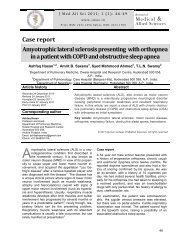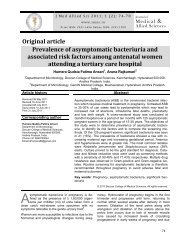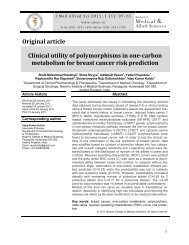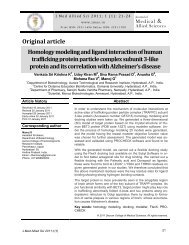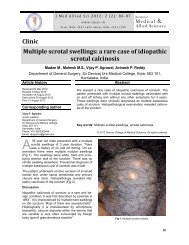Prosthodontic management of mandibular deviation using palatal ...
Prosthodontic management of mandibular deviation using palatal ...
Prosthodontic management of mandibular deviation using palatal ...
You also want an ePaper? Increase the reach of your titles
YUMPU automatically turns print PDFs into web optimized ePapers that Google loves.
Case report<br />
J M e d A l l i e d S c i 2 0 1 2 ; 2 ( 2 ) : 77- 80<br />
w w w . j m a s . i n<br />
P r i n t I S S N : 2 2 3 1 1 6 9 6 O n l i n e I S S N : 2 2 3 1 1 7 0 X<br />
Journal <strong>of</strong><br />
Medical &<br />
Allied Sciences<br />
<strong>Prosthodontic</strong> <strong>management</strong> <strong>of</strong> <strong>mandibular</strong><br />
<strong>deviation</strong> <strong>using</strong> <strong>palatal</strong> ramp appliance<br />
Prince Kumar 1 , Chandni Jain 2 , Ashish Kumar 1 , Harkanwal Preet Singh 3<br />
1 Department <strong>of</strong> <strong>Prosthodontic</strong>s and 3 Department <strong>of</strong> Oral Pathology; ITS Dental College, Muradnagar,<br />
Ghaziabad 201 206, Uttar Pradesh, India.<br />
2 Private Practitioner, Jabalpur, Madhya Pradesh, India.<br />
Article history: Abstract<br />
Received 25 March 2012<br />
Revised 30 June 2012<br />
Accepted 31 July 2012<br />
Early online 30 August 2012<br />
Print 31 August 2012<br />
Corresponding author<br />
Prince Kumar<br />
Department <strong>of</strong> <strong>Prosthodontic</strong>s,<br />
ITS Dental College,<br />
Muradnagar, Ghaziabad 201 206,<br />
Uttar Pradesh, India.<br />
Phone: +91 9412860201<br />
Email: poojagupta20032007@gmail.com<br />
I<br />
n this modern era, one <strong>of</strong> the most challenging<br />
and demanding maxill<strong>of</strong>acial endeavors is the<br />
fabrication <strong>of</strong> functional complete dentures for<br />
the edentulous patient who has undergone a <strong>mandibular</strong><br />
resection. The extent <strong>of</strong> <strong>mandibular</strong> resection<br />
and loss <strong>of</strong> continuity is directly related to the<br />
decreased masticatory function. On the contrary,<br />
patients with <strong>mandibular</strong> resections resulting in<br />
little s<strong>of</strong>t tissue loss have less <strong>mandibular</strong> <strong>deviation</strong>.<br />
Segmental resection <strong>of</strong> the mandible results in<br />
significant physiological and esthetic problems,<br />
especially if condylectomy has been performed.<br />
The most important difficulty encountered is <strong>mandibular</strong><br />
<strong>deviation</strong> towards the defective side 1 . The<br />
earlier that <strong>mandibular</strong> guidance therapy initiated<br />
in the course <strong>of</strong> treatment, the more successful the<br />
patient's definitive occlusal relationship and masti-<br />
Segmental resection <strong>of</strong> the mandible generally results in <strong>deviation</strong><br />
<strong>of</strong> the mandible to the defective side. This loss <strong>of</strong> continuity <strong>of</strong> the<br />
mandible destroys the balance <strong>of</strong> the lower face and leads to decreased<br />
<strong>mandibular</strong> function by <strong>deviation</strong> <strong>of</strong> the residual segment<br />
toward the surgical site. Prosthetic methods advocated to reduce<br />
or eliminate <strong>mandibular</strong> <strong>deviation</strong> include intermaxillary fixation,<br />
removable <strong>mandibular</strong> guide flange, <strong>palatal</strong> ramp, implantsupported<br />
prosthesis and <strong>palatal</strong> guidance restorations which may<br />
be useful in reducing <strong>mandibular</strong> <strong>deviation</strong> and improving masticatory<br />
performance and efficiency. These methods and restorations<br />
would be combined with a well organized <strong>mandibular</strong> exercise<br />
regimen. This clinical report describes the rehabilitation following<br />
segmental mandibulectomy <strong>using</strong> <strong>palatal</strong> ramp prosthesis.<br />
Key words: Hemi-mandibulectomy, rehabilitation, <strong>palatal</strong> ramp,<br />
carcinoma<br />
© 2012 Deccan College <strong>of</strong> Medical Sciences. All rights reserved.<br />
catory efficiency. Any delays in the initiation <strong>of</strong><br />
<strong>mandibular</strong> guidance appliance therapy, due to<br />
problems such as extensive tissue loss, radiation<br />
therapy, radical neck dissection, flap necrosis and<br />
other post surgical morbidities, may result in an<br />
inability to achieve normal maxillo<strong>mandibular</strong> relationships<br />
2,3 . Intermaxillary fixation, <strong>mandibular</strong>based<br />
guidance restorations, and <strong>palatal</strong> based<br />
guidance restorations will reduce or minimize this<br />
<strong>mandibular</strong> <strong>deviation</strong>.<br />
A well organized <strong>mandibular</strong> exercise program<br />
should always accompany these methods. Any<br />
uncoordinated masticatory movements may result<br />
in dental or s<strong>of</strong>t tissue trauma, including severe lip<br />
or tongue lacerations and hemorrhage 4 . So, monitoring<br />
the lesion, smoothening sharp teeth, <strong>using</strong><br />
oral appliances, extracting problematic teeth or<br />
inhibiting behaviors such as self-mutilation <strong>of</strong> lips,<br />
77
Kumar P et al. Prosthetic <strong>management</strong> <strong>of</strong> segmental mandibulectomy<br />
cheeks and tongue are the best solutions for such<br />
s<strong>of</strong>t tissue trauma. This article describes the fabrication<br />
<strong>of</strong> <strong>palatal</strong> ramp type guidance appliance<br />
with supporting flanges for a patient following a<br />
segmental mandibulectomy.<br />
Case report<br />
A 64 year old male patient reported with the chief<br />
complaint <strong>of</strong> <strong>deviation</strong> <strong>of</strong> the lower jaw while closing<br />
the mouth (Fig 1) along with difficulty in eating.<br />
He wanted functional rehabilitation.<br />
Fig 1. Extraoral view <strong>of</strong> patient showing marked <strong>mandibular</strong><br />
<strong>deviation</strong> towards right side.<br />
The patient's history indicated that 3 years back he<br />
was surgically treated for the Pindborg tumor on<br />
right <strong>mandibular</strong> molar region (Fig 2). Right <strong>mandibular</strong><br />
resection was followed by mini-plating on<br />
right side.<br />
Fig 2. Orthopantomograph showing resected mandible.<br />
In June 2011, he complained <strong>of</strong> swelling and pain<br />
at the same site. Infected bone mini-plates were<br />
removed in June 2011. There was marked <strong>deviation</strong><br />
towards the resected site due to resection <strong>of</strong><br />
muscle attachments along with body <strong>of</strong> the mandible.<br />
J Med Allied Sci 2012;2(2)<br />
Clinical examination and treatment planning<br />
The <strong>mandibular</strong> defect reported in this clinical report<br />
is Cantor and Curtis 5 class II defect (lateral<br />
resection <strong>of</strong> the mandible distal to the cuspid).<br />
Temporo-<strong>mandibular</strong> joint (TMJ) examination revealed<br />
severe <strong>deviation</strong> <strong>of</strong> the mandible towards<br />
the resected side (Fig 3).<br />
Fig 3. Intraoral view showing <strong>mandibular</strong> <strong>deviation</strong>.<br />
Intraoral examination revealed an intact natural<br />
dentition in maxillary arch whereas <strong>mandibular</strong><br />
teeth present were on un-resected part. The tissue<br />
bed in the edentulous region was not displaceable<br />
and the denture foundation in the edentulous area<br />
was ideal for the support. Based on the clinical<br />
situation, a <strong>palatal</strong> ramp type guidance appliance<br />
was planned (Fig 4).<br />
Fig 4. Palatal ramp prosthesis.<br />
It was noted that the patient lacks motor control to<br />
bring the mandible into centric occlusion. Definitive<br />
impressions were made with addition <strong>of</strong> polysilicone<br />
(Coltene Whaledent, Switzerland). Definitive<br />
casts were poured with type IV dental stone (Kalrock,<br />
Kalabhai Karson Pvt. Ltd., Mumbai, India).<br />
Over the maxillary cast a simple retainer type <strong>of</strong><br />
appliance was made. The retainer was checked for<br />
adaptation in oral cavity. A crib was adapted on the<br />
cast to reinforce the acrylic extension <strong>of</strong> the appliance.<br />
Auto polymerizing acrylic resin was added<br />
78
Kumar P et al. Prosthetic <strong>management</strong> <strong>of</strong> segmental mandibulectomy<br />
to this retention plate and when acrylic resin<br />
reached doughy stage, mandible was manipulated<br />
to the desired interocclusal relationship. This<br />
movement was repeated several times. The resin<br />
was manipulated to extend 7-10 mm superiorly.<br />
After this, prosthesis was removed from the mouth<br />
and resin was allowed to polymerize. The appliance<br />
was finished, evaluated and adjusted intraorally.<br />
It was noted that the patient was able to<br />
achieve a functional intercuspal position immediately<br />
after insertion <strong>of</strong> the prosthesis. The prosthesis<br />
was removed from the mouth, repolished<br />
and inserted (Fig 5).<br />
Fig 5. Final prosthesis in patient's mouth.<br />
The patient was given routine post insertion instructions<br />
and was motivated to learn to adapt to<br />
the new prosthesis. Simple exercises were suggested<br />
to the patient that helped the patient learn<br />
to manipulate the mandible into the proper position.<br />
Discussion<br />
Successful rehabilitation <strong>of</strong> edentulous mandibulectomy<br />
patients is more difficult than that <strong>of</strong> a dentulous<br />
patient. Sharry 6 described the difficulties<br />
encountered as:<br />
i. Limited coverage and retention<br />
ii. Grossly impaired relation <strong>of</strong> the mandible to<br />
the maxilla<br />
iii. Limited movement <strong>of</strong> the mandible<br />
iv. Loss <strong>of</strong> facial structures, sensory and motor<br />
innervations complicates the control factors.<br />
Mandibular treatment prosthesis is very helpful in<br />
reducing the unavoidable sequelae resulting from<br />
extensive <strong>mandibular</strong> resection like muscular contraction,<br />
mutilation <strong>of</strong> occlusal plane, scar contracture,<br />
etc. Its success varies and depends upon the<br />
nature, size and site <strong>of</strong> the surgical defect, initiation<br />
<strong>of</strong> the guidance therapy, patient's expectation, cooperation<br />
and other factors. Modification to these<br />
principles are determined on an evidence basis<br />
and greatly influenced by unique residual tissue<br />
characteristics and dynamics and science <strong>of</strong> <strong>mandibular</strong><br />
movement 7 . As described in this report, the<br />
<strong>mandibular</strong> guidance prosthesis consisted <strong>of</strong> a re-<br />
J Med Allied Sci 2012;2(2)<br />
movable partial denture framework, with a flange<br />
extending laterally and superiorly on the buccal<br />
aspect <strong>of</strong> the bicuspids and molars on the non defect<br />
side. This flange engages the maxillary teeth<br />
during <strong>mandibular</strong> closure, thereby directing the<br />
mandible into an appropriate intercuspal position.<br />
Earlier the <strong>mandibular</strong> guidance therapy is initiated<br />
in the course <strong>of</strong> treatment, more successful the<br />
patient's definitive occlusal relationship. Mandibular<br />
guidance therapy begins when immediate postsurgical<br />
sequelae have subsided, usually two<br />
weeks after surgery. Various other methods advocated<br />
to reduce or eliminate <strong>mandibular</strong> <strong>deviation</strong><br />
include <strong>mandibular</strong> guidance therapy, intermaxillary<br />
fixation, resection guidance restorations,<br />
splinting, and fabrication <strong>of</strong> prosthesis similar to<br />
'swing lock' removable partial dentures. For best<br />
results, these methods and restorations would be<br />
combined with a well-organized <strong>mandibular</strong> exercise<br />
regimen. An implant-supported fixed prosthesis<br />
can be an optional treatment modality for functional<br />
and esthetic rehabilitation. The use <strong>of</strong> resection<br />
guidance restoration is predicted on the basis<br />
<strong>of</strong> presence <strong>of</strong> maxillary and <strong>mandibular</strong> teeth, as<br />
presence <strong>of</strong> teeth in both arches is important for<br />
effective guidance and reprogramming <strong>of</strong> <strong>mandibular</strong><br />
movement. This patient retained all <strong>of</strong> his maxillary<br />
dentition, remaining <strong>mandibular</strong> dentition i.e.<br />
from left third molar to right central incisor and proprioceptive<br />
sensation. For the patient, this prosthesis<br />
provided comfort and sufficient function, and he<br />
was able to achieve functional intercuspal position<br />
immediately after the insertion <strong>of</strong> the prosthesis. A<br />
removable prosthesis is an equally effective alternative<br />
for most patients with <strong>mandibular</strong> defects,<br />
considering the poor prognosis, difficulty in decision<br />
making for use <strong>of</strong> implant and economic feasibility.<br />
Conclusion<br />
This clinical report describes the prosthetic rehabilitation<br />
following segmental mandibulectomy with<br />
<strong>mandibular</strong> guide flange prosthesis. Certain basic<br />
principles <strong>of</strong> construction <strong>of</strong> conventional dentures<br />
should be modified for <strong>mandibular</strong> resection patients<br />
because <strong>of</strong> many restrictive physical factors.<br />
The philosophical approach to the treatment and<br />
rehabilitation <strong>of</strong> such patients with resected mandibles<br />
is not in concentrating on what has been<br />
sacrificed in the treatment <strong>of</strong> the disease, but rather<br />
in taking full advantage <strong>of</strong> the remaining structures.<br />
With the mode <strong>of</strong> treatment provided the<br />
patient expressed satisfaction with the mastication<br />
and esthetics.<br />
Acknowledgments: None<br />
Source <strong>of</strong> support: None<br />
79
Kumar P et al. Prosthetic <strong>management</strong> <strong>of</strong> segmental mandibulectomy<br />
Conflict <strong>of</strong> interest: None<br />
References<br />
1. Beumer J III, Curtis TA, Marunick MT. Maxill<strong>of</strong>acial rehabilitation:<br />
<strong>Prosthodontic</strong> and surgical consideration. Ishiyaku.<br />
Euro America, St. Louis, USA, pp.184-188, 1996.<br />
2. Sahin N, Hekimoglu C, Asian Y. The fabrication <strong>of</strong> cast<br />
metal guidance flange prostheses for a patient with segmental<br />
mandibulectomy: A clinical report. J Prosthet Dent<br />
2005; 93:217-220.<br />
3. Ufuk H, Sadullah U, Ayhan G. Mandibular guidance prosthesis<br />
following resection procedures: Three case reports.<br />
Eur J Prosthodont Rest Dent 1992; 1:69-72.<br />
J Med Allied Sci 2012;2(2)<br />
4. Oelgiesser D, Levin L, Barak S, Schwartz DA. Rehabilitation<br />
<strong>of</strong> an irradiated mandible after <strong>mandibular</strong> resection<br />
<strong>using</strong> implant/tooth supported fixed prosthesis: A clinical<br />
report. J Prosthet Dent 2004; 91:31-34.<br />
5. Cantor R and Curtis TA. Prosthetic <strong>management</strong> <strong>of</strong> edentulous<br />
mandibulectomy patients. Part 1. Anatomic, physiologic<br />
and psychologic consideration. J Prosthet Dent 1971;<br />
25:446-457.<br />
6. Sharry JJ. Extension <strong>of</strong> partial denture treatment. Dent Clin<br />
North Am 1962; 6:821-835.<br />
7. Beumer J, Curtis T, Firtell D (Eds.). Maxill<strong>of</strong>acial rehabilitation.<br />
Mosby, St. Louis, USA, pp. 90-169, 1979.<br />
80



